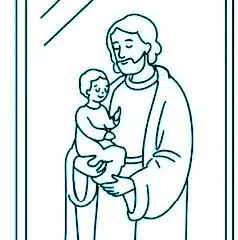Adultery of the Heart, Part 3
Note: This article is part of an ongoing series on Pope St. John Paul II’s “Theology of the Body” (TOB).
The New Law of the Gospel given to us by Christ calls us to conversion of heart. External conformity to the moral law is not sufficient. God desires the whole person to be transformed such that good moral acts flow naturally from a heart made new by the Holy Spirit.
As discussed in the previous reflection, Pope St. John Paul II saw the human heart, wounded by sin, as a “battlefield between love and concupiscence” (TOB 32:3). Concupiscence (i.e., disordered desire) moves us to see others’ bodies as mere objects for our personal satisfaction. Rather than seeing the body as the outward expression of a person who possesses dignity and freedom and ought never be reduced to a mere object, concupiscence moves us to see the body in terms of what it can do for me. As John Paul II said, “The more concupiscence dominates the heart, the less the heart experiences the spousal meaning of the body, and the less sensitive it becomes to the gift of the person” (TOB 32:3). Instead of seeing one another as gifts to honor and receive in holiness, concupiscence moves us to see one another “as an object to appropriate” (TOB 33:1).
Adultery occurs when “a man and a woman who are not husband and wife form ‘one flesh’” (TOB 37:6). These overt acts are condemned both in the Old and New Law. What about adultery in the heart? Jesus teaches us, “Every one who looks at a woman lustfully has already committed adultery with her in his heart” (Mt. 5:28). According to Pope St. John Paul II, “the look expresses what is in the heart” (TOB 39:4, italics in original). In other words, the way we look at one another reflects the state of our hearts and, even more, our intentions. What Jesus is calling us to repent of is a kind of “intentional reduction” of the person in the way we think about and behold one another (TOB 40:3).
If, in my heart, other people cease to be persons made in God’s image whose immeasurable dignity I am called to honor and uphold, then the way I look at them will be motivated by selfish, disordered desire (concupiscence). When sexuality is involved, we call this concupiscent desire “lust.” This lustful, concupiscent sexual desire “tramples on the ruins of the spousal meaning of the body… [and] aims directly toward one and only one end as its precise object: to satisfy only the body’s sexual urge” (TOB 40:4). Rather than being oriented to an exclusive, permanent gift of self through marriage, this distorted (lustful) sexual desire becomes merely about giving me pleasant feelings. For the person dominated by lust, the body of another becomes “above all an object for the possible satisfaction of his own sexual ‘urge’” (TOB 43:3).
When I tolerate, allow, or to any degree intentionally permit myself to look at others in this reductionist way, as objects to satisfy my lust, then I commit the sin of adultery in the heart. Like all sin, this particular sin wounds myself, others and the Body of Christ. It continues and compounds the effects of The Fall by increasing the disharmony between man and God, within man himself, and between human persons. It offends against our human dignity, the spousal meaning of the body and the purity of heart to which all are called.
Understood in this way, we can begin to see that the marital status of the people involved matters very little in regard to adultery in the heart since it pertains to our basic attitude and intentions toward other people—our way of looking at our brothers and sisters. Thus, it should be no surprise that John Paul II taught that this sin can even occur within marriage: “A man can commit such adultery ‘in the heart’ even with his own wife, if he treats her only as an object for the satisfaction of drives” (TOB 43:3). While this aspect of the saintly pope’s teaching shocked some of his original audience, if we allow Christ to continue to purify our hearts, we will receive it with gratitude and increasingly see it as an essential protection and guide to authentic spousal love and sexual desire itself.
 Dr. Andrew Sodergren, MTS, PSY.D is a Catholic psychologist and director of psychological services for Ruah Woods. He speaks on the integration of psychology and the Catholic faith. He and his wife, Ellie, have five children.
Dr. Andrew Sodergren, MTS, PSY.D is a Catholic psychologist and director of psychological services for Ruah Woods. He speaks on the integration of psychology and the Catholic faith. He and his wife, Ellie, have five children.
This article appeared in the February 2024 edition of The Catholic Telegraph Magazine. For your complimentary subscription, click here.














